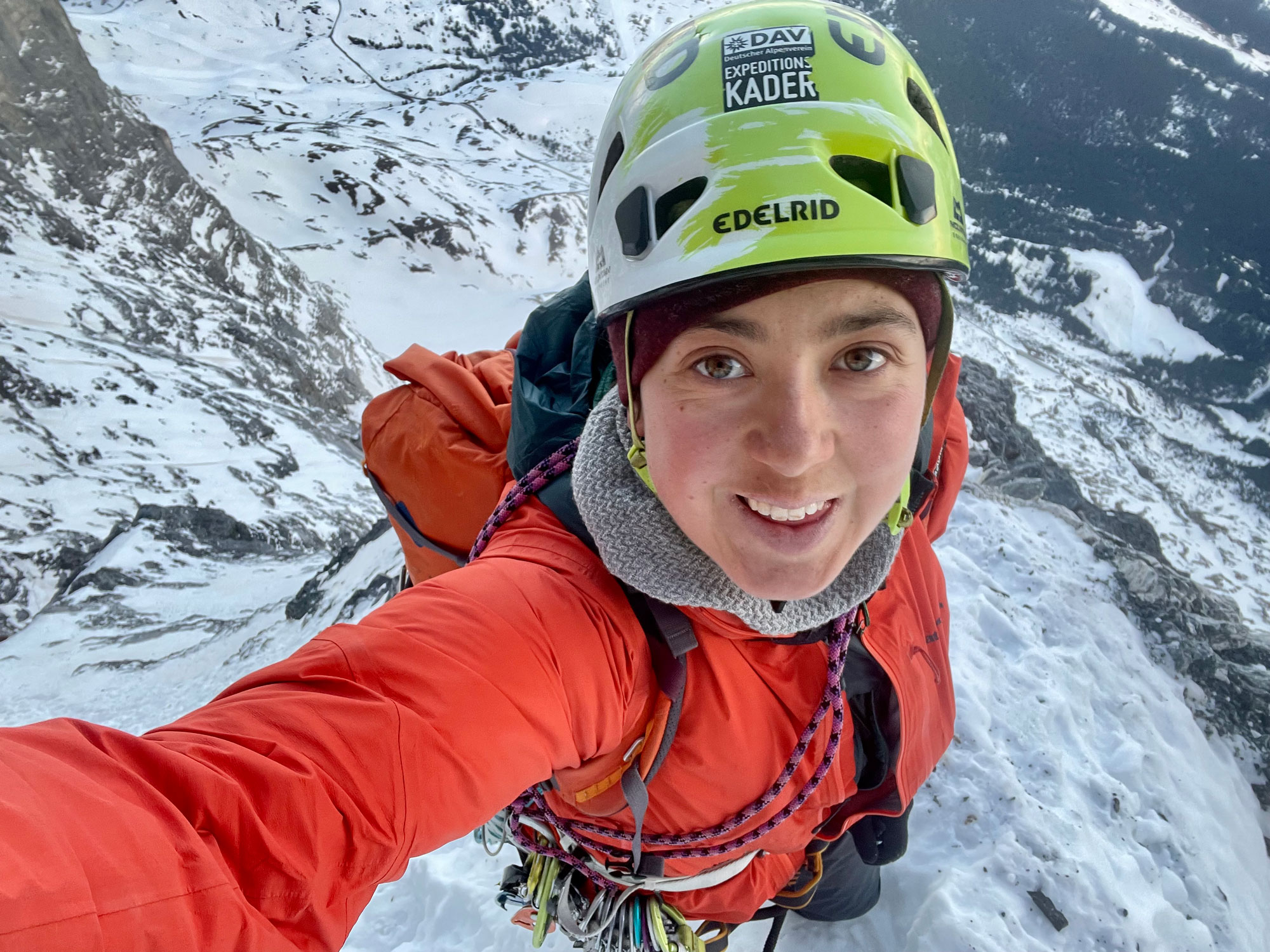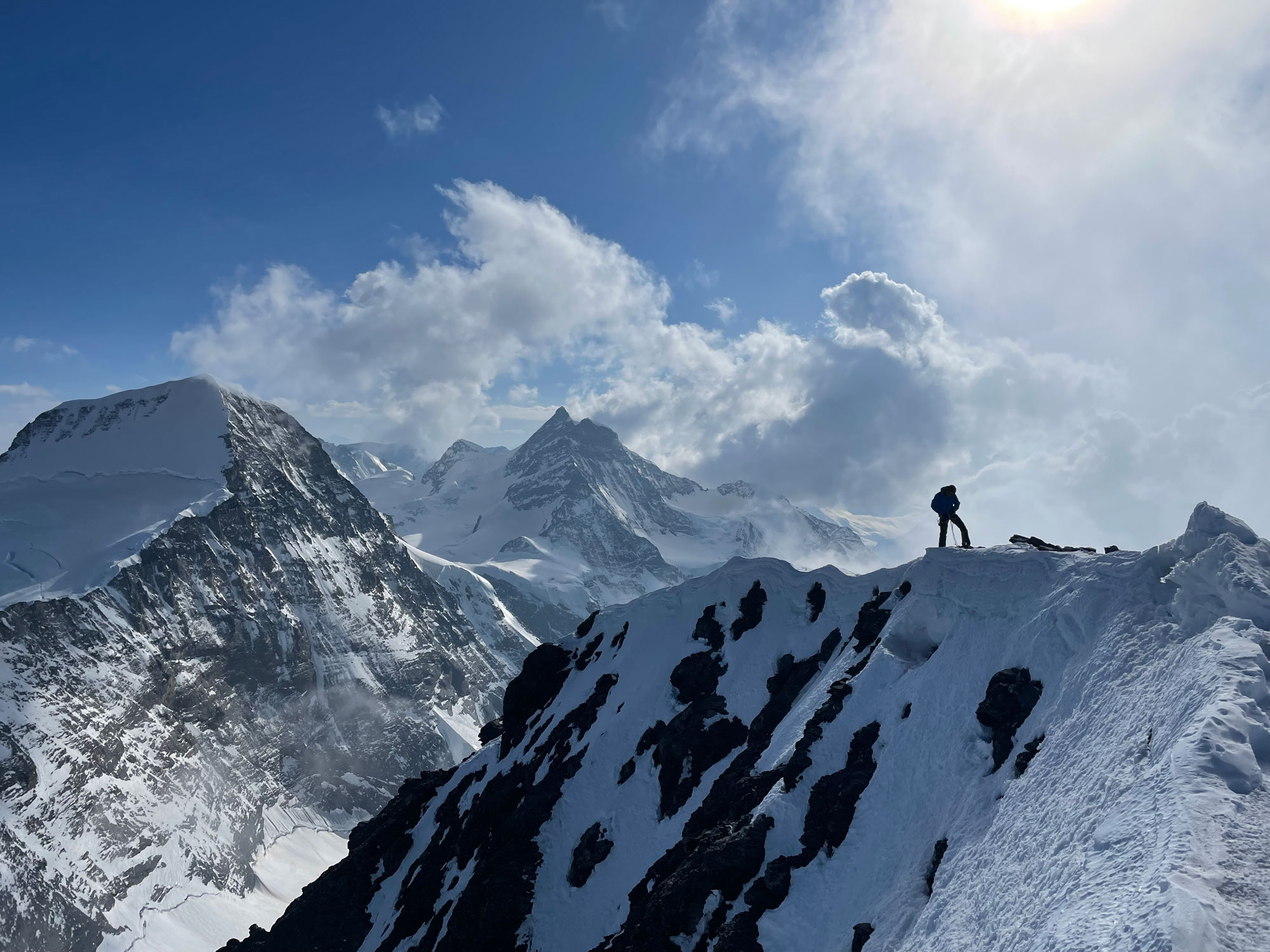
On March 25, 2022, after 15 hours of climbing, Laura Tiefenthaler became the second known woman to solo the Heckmair Route on the Eiger’s legendary North Face. The last known female solo of the route was 30 years ago: a 17-hour push by mountaineering icon Catherine Destivelle, who onsighted it in 1992. Two women have also soloed the nearby Northeast Face: Alison Hargreaves in 1993 and Evelyne Binsack in 1994, both via the Lauper Route in summer. According to Eiger historians Rainer Rettner and Roger Schaeli (the latter has climbed the peak 50 times himself), this ascent makes Tiefenthaler the second known woman to solo the iconic North Face of the Eiger. (See the map of Eiger routelines from Alpinist 2.)
Once referred to as “the last Alpine problem,” the Eiger’s vast 1,800-meter North Face has lain under a shroud of myth and mystery since it was first attempted in the 1930s, says Rettner. After a slew of sometimes-deadly attempts, the face was first climbed in 1938. For decades after, the peak’s subsequent ascents still made headlines across Europe. So did its fatalities. Even today, despite nearly a century of successful ascents, the Eiger’s imposing North Face still holds onto its legendary aura. The psychological weight of the route remains poignant, Rettner notes.
Tiefenthaler, who grew up in Innsbruck, Austria, was one of many drawn to the stories of the mountain. She started climbing around age 10 and soon ventured into the peaks surrounding her hometown. By her late teens, she’d become an accomplished climber, and she was accepted to the 2017 class of the German Alpine Club’s prestigious young female alpinist team. Since then, she has climbed Cerro Torre with Raphaela Haug and Fabian Buhl in Patagonia in 2020 and completed the Heckmair Route with partner Jana Moehrer just two weeks before her solo.
At that point, Tiefenthaler had just graduated from medical school and had some time on her hands. So, she texted Rolo Garibotti, an accomplished alpinist based in Patagonia and Austria. Garibotti has been a mentor of sorts for Tiefenthaler over the years; they met through the German Alpine Club’s young female alpinist team, which Garibotti’s ex-partner Doerte Pietron helped start.
“I was considering a solo of a traverse near Innsbruck, which was quite chossy and would have a lot of uncertainty,” Tiefenthaler says. “So I spoke to Rolo about it, and he said, ‘What about going back to the Eiger?'”
Tiefenthaler considered the suggestion. She’d felt strong and confident roped up with Moehrer, and she was by now familiar with the route. She checked the conditions. Much of the Heckmair would be a bit dry for her tastes, she knew, but it had been weeks since the Eiger’s North Face had seen snow, and dozens of other climbers had taken advantage of the stable conditions. The more she thought about it, the more excited she became about the idea of a solo day on the mountain.
At the time, it didn’t cross her mind–or Garibotti’s–that Destivelle was still the only female soloist to summit the Eiger North Face. The historical nature of the ascent wouldn’t occur to either of them until long after Tiefenthaler had reached the ground.
Tiefenthaler told Garibotti she was going to go for it. She packed up her gear and started driving. He offered to pay for her gas–both to support her dream, and to remove any pressure of sunk cost so that she would be able to be honest with herself and her motivation every step of the way. This systematic removal of pressure would become key to her success.
On March 23, the night before her climb, Tiefenthaler sat alone in the train station with her gear. Slowly, she felt her mind fill with doubts.
“I was worried that I was doing a stupid thing,” she explains. “It can be hard to know where your motivation comes from. It’s important to me that I don’t do it for the success [or the summit]–I want to have fun. For me, climbing is too dangerous to [be driven by a] need for success.”
Tiefenthaler calls herself “a holiday climber.” She wants to devote her life to work as a doctor–a general practitioner–and keep climbing firmly relegated as a hobby. According to Garibotti, she’s adamant about turning down any sponsorships to ensure that her motivations remain pure and that climbing never feels like work.
So, that night in the train station, Tiefenthaler checked in with herself. And she decided that yes: She wanted to be here. She wanted to climb this route–and purely for the fun of it.
The next morning, she woke up well before dawn and started up. But just a few pitches in, she found she’d made a wrong turn. It took her two and a half hours to get back on track. At that point, she decided to come down and spend the day at the train station, resting and reassessing.
“She was a little bit stressed after this first attempt,” Garibotti said. “She said it felt like a university exam.” Basically, she was putting too much pressure on herself. So, Tiefenthaler came up with a plan.
Tiefenthaler knew exactly where on the route the point of no return would be. She’d take the mountain one step at a time, constantly assessing to ensure her strength and confidence were there. She also resolved to approach the route without any goals in mind–just curiosity about the outcome, whatever it may be.
The new approach worked. The next day, she says, all trace of nerves disappeared. She started at 1:00 a.m. By dawn, she had found her flow. By the time she reached her point of no return, “I knew there was no question that I would go on,” she says. She reached the summit at 4:00 p.m.
“At the top, I was smiling over my whole face,” she says. “Success is nice, but I knew I wasn’t doing it for the success. I was happy that I did it. I was happy that I wasn’t scared anymore.”

Tiefenthaler’s ability to detach totally from the result, Garibotti says, is what makes her special.
“For her, it was just like, ‘OK there’s a learning opportunity. There’s a chance to explore emotions I haven’t experienced before, so let’s go and see,'” he explains. “Laura is committed, but she’s very clear that she just wants to do this for fun. She’s very centered, very down to earth.”
The true triumph of this ascent, Garibotti says, is not just that Tiefenthaler was able to reach the extremely high bar that Catherine Destivelle set. (The bar was high, Rettner emphasizes. Afterall, Destivelle’s ascent was an onsight. And without the benefit of modern forecasting tools, alpinism in the early 1990s was fraught with far more uncertainty, he adds). What is remarkable, Garibotti explains, is that Tiefenthaler was also able to do it for what she considered to be the right reasons for herself, without succumbing to outside pressure or expectation.
“I don’t think there are that many 25-year-olds that can do that [kind of solo],” Garibotti says. “She went and had a really meaningful experience discovering that she could psychologically manage a project that big in a mentally healthy way.”
“Fifteen hours is pretty fast for someone who doesn’t know the route by heart like the climbers who are going for speed records on the Eiger North Face,” mountaineering writer and historian Karin Steinbach adds. (The late Ueli Steck holds the current speed record, at two hours and 22 minutes for the Heckmair Route, which he also soloed.) “But it seems like Laura wasn’t going for speed in her attempt. She wanted to be safe, so she rope-soloed the hard pitches, and that takes some time. The Eiger North Face has always been an important measure [of skill]. The rock can be rotten and precarious, and the face is exposed to sudden changes of weather. If there’s a thunderstorm moving in, it comes from the south, behind the mountain, so you don’t notice it. Suddenly fog falls down from the summit, there’s rain or hail, and the rock can get glazed with ice from one minute to the next. It is a completely different thing to climb through such a challenging wall alone. [To do it, one] needs a very strong mind.”